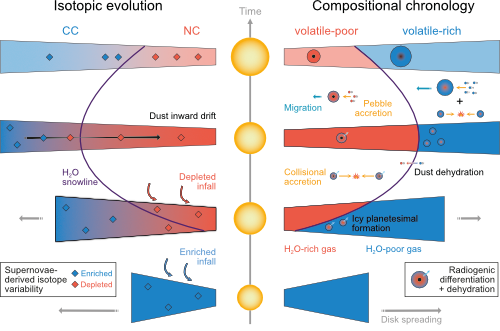EPSC Abstracts
Vol.14, EPSC2020-243, 2020
https://doi.org/10.5194/epsc2020-243
Europlanet Science Congress 2020
© Author(s) 2020. This work is distributed under the Creative Commons Attribution 4.0 License.
Earliest isotopic and chemical bifurcation of planetary building blocks
- 1Atmospheric, Oceanic and Planetary Physics, University of Oxford, United Kingdom (tim.lichtenberg@physics.ox.ac.uk)
- 2University Observatory, Ludwig Maximilian University of Munich, Germany
- 3Institute of Geochemistry and Petrology, ETH Zurich, Switzerland
- 4Bayerisches Geoinstitut, University of Bayreuth, Germany
- 5Institute for Computational Science, University of Zurich, Switzerland
Recent astronomical (1,2) and geochemical (3,4) evidence point to early spatial and temporal fragmentation of the planet formation process, whose physical origins remain disputed. Here, using a coupled numerical model, we investigate the influence of the build-up of the solar protoplanetary disk (5) on the timing and internal evolution (6) of forming protoplanets. We find that the orbital drift of the water iceline can generate two temporally and spatially distinct bursts of planetesimal formation, which sample different source regions of interstellar materials and experience limited intermixture. Driven by internal radiogenic heating, these planetary reservoirs compositionally evolve in two modes and recover accretion chronology, thermo-chemical pattern, and mass divergence of inner and outer Solar System. Our numerical experiments suggest that the earliest interplay between disk physics and geophysical evolution of accreting planetesimals initiated the present-day observed chemical and isotopic dichotomy of the Solar System planets.

Figure caption: Schematic illustration of early Solar System accretion chronology suggested by our numerical experiments. Isotope variability (left) across the disk due to varying composition of infall material is retained by the traffic-jam of inward-drifting dust grains at the water iceline. The formation of two distinct planetesimal populations initiates divergent evolutionary pathways of inner and outer Solar System (right) due to the combined effects of internal radiogenic heating and secular variation of the dominant mode of planetary growth.
References
How to cite: Lichtenberg, T., Dra̧żkowska, J., Schönbächler, M., Golabek, G. J., and Hands, T. O.: Earliest isotopic and chemical bifurcation of planetary building blocks, Europlanet Science Congress 2020, online, 21 September–9 Oct 2020, EPSC2020-243, https://doi.org/10.5194/epsc2020-243, 2020

